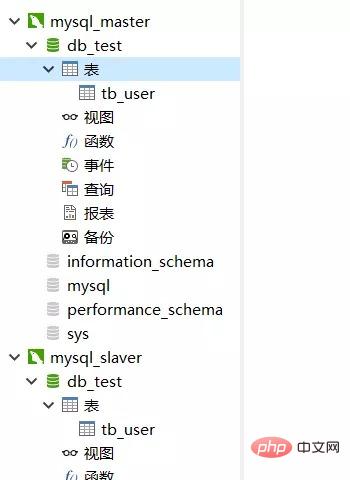MySQL implements master-slave replication function

Environment Description
centos7.3, MySQL5.7
Foreword
MySQL installation reference previous article https:// www.jianshu.com/p/452aa99c7476 has an explanation.
Basic Concepts
MySQL’s built-in replication capabilities are the foundation for building large-scale, high-performance applications. Distribute hundreds of millions of MySQL data to multiple systems. This distribution mechanism is achieved by copying the data of a certain MySQL host to other hosts (Slave) and executing it again. During replication one server acts as the server and one or more other servers act as slaves. The master writes updates to the binary log and maintains an index of the files to track log rotation. These logs record updates sent to slave servers. When a slave connects to the master, it notifies the master of the location of the last successful update the slave read in the log, the slave receives any updates that have occurred since then, then blocks, etc. The master notifies new updates. . Please note that when you replicate, all updates to the replicating tables must be made on the master server. Otherwise, you must be careful to avoid conflicts between updates made by users to tables on the master server and updates to tables on the server
Master-slave replication implementation
一, Modify the master server
If you installed MySQL according to the article I wrote, then the my.cnf configuration file is in the /etc/ directory. If it is not there, you can search it through the whereis command. Add the following configuration under the my.cnf configuration file
server_id=1 #指定MySQL的id log-bin=mysql-bin #开启二进制日志文件
2. Create a replication account
Execute this command in the main server (all are allowed here Address access, it is recommended to set it to the address of the slave server)
GRANT REPLICATION SLAVE ON *.* to 'replication'@'%' identified by 'Abc123...';
Three. Modify the slave server
server_id=2 log-bin=mysql-bin binlog_do_db=db_test#表示要同步的数据库
Instructions: binlog-ignore-db=test means unsynchronized test database binlog_do_db=db_test #Indicates the database to be synchronized
4. Restart MySQL
Restart both the master server and the slave server
service mysqld restart
5. Check the status of the master server
show master status
Results As follows:
Some information needs to be recorded here, which needs to be used when configuring the slave server# 6. Configure the slave server (connect to the Master server)
change master to master_host='192.168.74.129',master_user='replication',master_password='Abc123...',master_log_file='mysql-bin.000001',master_log_pos=2041;
master_host is the ip of the master server master_port=3306 (There is no configuration here, the default is 3306) master_user: Master server authorized user, that is, the user created before Master master_password: Master server authorized user corresponding password master_log_file: Master binlog file name master_log_pos: Postion value in Master binlog file about position value , here is a note: If the master server already has a lot of data, you first need to back up the data of the master server to the slave server, and then use the show master status command to record the location where synchronization needs to be started. # 7. Start replication and execute
start slave
on the slave server. The stop command is: stop slave; The two circled results are yes, indicating that the master-slave replication configuration is successful. If the configuration fails, you can check the failure information in the MySQL log file, or you can check a brief error message through the above command:

This is the master-slave server I just configured The main reason for the error is that the UUID of the MySQL server conflicts. The reason is that my slave server is copied from the master server. Just go to /var/lib/mysql/auto.cnf and modify it. #Verify the current status of the master-slave results:

#View the slave server

You can see that it has been synchronized and synchronized in the past
For more MySQL related technical articles, please visit the MySQL Tutorial column to learn!
The above is the detailed content of MySQL implements master-slave replication function. For more information, please follow other related articles on the PHP Chinese website!

Hot AI Tools

Undresser.AI Undress
AI-powered app for creating realistic nude photos

AI Clothes Remover
Online AI tool for removing clothes from photos.

Undress AI Tool
Undress images for free

Clothoff.io
AI clothes remover

AI Hentai Generator
Generate AI Hentai for free.

Hot Article

Hot Tools

Notepad++7.3.1
Easy-to-use and free code editor

SublimeText3 Chinese version
Chinese version, very easy to use

Zend Studio 13.0.1
Powerful PHP integrated development environment

Dreamweaver CS6
Visual web development tools

SublimeText3 Mac version
God-level code editing software (SublimeText3)

Hot Topics
 1378
1378
 52
52
 MySQL: Simple Concepts for Easy Learning
Apr 10, 2025 am 09:29 AM
MySQL: Simple Concepts for Easy Learning
Apr 10, 2025 am 09:29 AM
MySQL is an open source relational database management system. 1) Create database and tables: Use the CREATEDATABASE and CREATETABLE commands. 2) Basic operations: INSERT, UPDATE, DELETE and SELECT. 3) Advanced operations: JOIN, subquery and transaction processing. 4) Debugging skills: Check syntax, data type and permissions. 5) Optimization suggestions: Use indexes, avoid SELECT* and use transactions.
 How to open phpmyadmin
Apr 10, 2025 pm 10:51 PM
How to open phpmyadmin
Apr 10, 2025 pm 10:51 PM
You can open phpMyAdmin through the following steps: 1. Log in to the website control panel; 2. Find and click the phpMyAdmin icon; 3. Enter MySQL credentials; 4. Click "Login".
 How to create navicat premium
Apr 09, 2025 am 07:09 AM
How to create navicat premium
Apr 09, 2025 am 07:09 AM
Create a database using Navicat Premium: Connect to the database server and enter the connection parameters. Right-click on the server and select Create Database. Enter the name of the new database and the specified character set and collation. Connect to the new database and create the table in the Object Browser. Right-click on the table and select Insert Data to insert the data.
 How to create a new connection to mysql in navicat
Apr 09, 2025 am 07:21 AM
How to create a new connection to mysql in navicat
Apr 09, 2025 am 07:21 AM
You can create a new MySQL connection in Navicat by following the steps: Open the application and select New Connection (Ctrl N). Select "MySQL" as the connection type. Enter the hostname/IP address, port, username, and password. (Optional) Configure advanced options. Save the connection and enter the connection name.
 MySQL and SQL: Essential Skills for Developers
Apr 10, 2025 am 09:30 AM
MySQL and SQL: Essential Skills for Developers
Apr 10, 2025 am 09:30 AM
MySQL and SQL are essential skills for developers. 1.MySQL is an open source relational database management system, and SQL is the standard language used to manage and operate databases. 2.MySQL supports multiple storage engines through efficient data storage and retrieval functions, and SQL completes complex data operations through simple statements. 3. Examples of usage include basic queries and advanced queries, such as filtering and sorting by condition. 4. Common errors include syntax errors and performance issues, which can be optimized by checking SQL statements and using EXPLAIN commands. 5. Performance optimization techniques include using indexes, avoiding full table scanning, optimizing JOIN operations and improving code readability.
 How to use single threaded redis
Apr 10, 2025 pm 07:12 PM
How to use single threaded redis
Apr 10, 2025 pm 07:12 PM
Redis uses a single threaded architecture to provide high performance, simplicity, and consistency. It utilizes I/O multiplexing, event loops, non-blocking I/O, and shared memory to improve concurrency, but with limitations of concurrency limitations, single point of failure, and unsuitable for write-intensive workloads.
 How to recover data after SQL deletes rows
Apr 09, 2025 pm 12:21 PM
How to recover data after SQL deletes rows
Apr 09, 2025 pm 12:21 PM
Recovering deleted rows directly from the database is usually impossible unless there is a backup or transaction rollback mechanism. Key point: Transaction rollback: Execute ROLLBACK before the transaction is committed to recover data. Backup: Regular backup of the database can be used to quickly restore data. Database snapshot: You can create a read-only copy of the database and restore the data after the data is deleted accidentally. Use DELETE statement with caution: Check the conditions carefully to avoid accidentally deleting data. Use the WHERE clause: explicitly specify the data to be deleted. Use the test environment: Test before performing a DELETE operation.
 MySQL: An Introduction to the World's Most Popular Database
Apr 12, 2025 am 12:18 AM
MySQL: An Introduction to the World's Most Popular Database
Apr 12, 2025 am 12:18 AM
MySQL is an open source relational database management system, mainly used to store and retrieve data quickly and reliably. Its working principle includes client requests, query resolution, execution of queries and return results. Examples of usage include creating tables, inserting and querying data, and advanced features such as JOIN operations. Common errors involve SQL syntax, data types, and permissions, and optimization suggestions include the use of indexes, optimized queries, and partitioning of tables.




